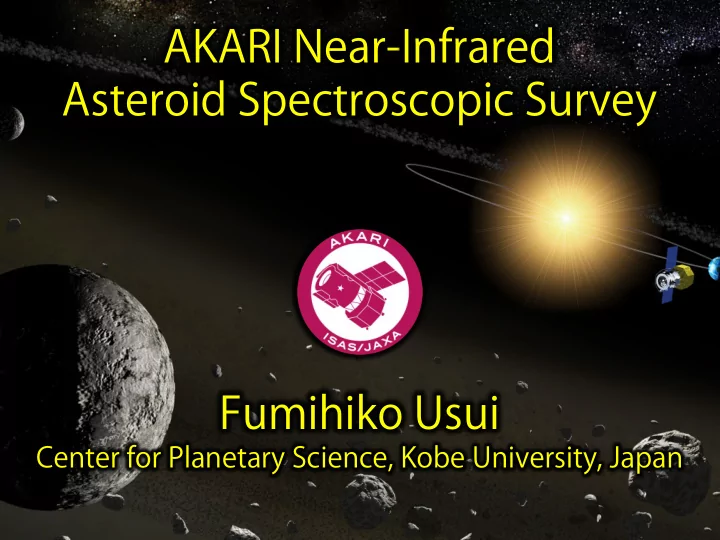

Center for Planetary Science, Kobe University, Japan Fumihiko Usui AKARI Near-Infrared Asteroid Spectroscopic Survey
Existence of “water” in the solar system anhydrous rock and liquid water are together (aqueous alteration). Infrared observations with ground-based telescopes are limited (e.g., Takir & Emery 2012, Takir+2015, Rivkin+2015, etc, etc, …) system. Earth's water, and unraveling the processes in the earliest times of the solar by atmospheric absorption. → Need to send telescopes into space! • Existence of “water” on asteroids – (1) Ceres:hydrated minerals (Rivkin+ 2002) 、water vapor (Küppers+2014) 、etc – (4) Vesta: hydrated minerals (Hasegawa+2003, Rivkin+2006, Russel+2015) – (24) Themis, (65) Cybele: water ice (Campins+ 2010; Rivkin+ 2010; Licandro+ 2011) • Hydrated minerals: – Any minerals containing OH or H 2 O, which are formed in environments where – They are found within chondrite matrix of meteorites. – Hydrated minerals are stable above the sublimation temperature of water ice. – Knowledge of the hydrated mineral is important for deducing the origin of – Diagnostic absorption features in 3 µm band Hydroxyl associated with hydrated mineral (2.7--2.8 µm) H 2 O ice (3.07 µm), etc
3 / 22 Infrared astronomical satellite “AKARI” The first Japanese infrared satellite dedicated to all-sky survey Orbit : 700km altitude, sun-synchronous Size : 5.5 x 1.9 x 3.7 m (in orbit) / Mass : 952kg (at launch) Telescope : Ritchey-Chretien, 68.5cm SiC (f/6) Launched : 2006/02/22 06:28 JST (JAXA M-V-8 rocket) Terminated : 2011/11/24 17:23 JST (c) JAXA (AKARI means “light” in Japanese.) • • • • •
Asteroid observations with AKARI (Hasegawa+2008, Müller+2014, 2017, etc) 25143 Itokawa Pointed observation data Distribution of AcuA asteroids http://www.ir.isas.jaxa.jp/AKARI/Archive/ observed asteroids (Hasegawa+2013, Deyama+ in prep.) (Usui+2011, 2013) (H < 9, >40 km in main belt; Usui+2014) Asteroid catalog using AKARI (AcuA) 162173 Ryugu • All-sky survey data (9, 18 µm) – Size and albedo catalog of 5120 asteroids: – Larger asteroids are fully covered. • Pointed observations (7-24 µm) – Studying mission target asteroids – Serendipitous survey • Archived photometric data of – Available at JAXA website: – Alí-Lagoa+2018 – Szakáts+ talk (this morning)
AKARI/IRC spectroscopic observations IRS Instrument Team+2011 Detection sensitivity [mJy] Spitzer (2003 -) (2006 - 2011) AKARI ISO (1995 - 1998) Leech+2003, Lorente+2008, d = 151 km (361) Bononia d = 973 km (1) Ceres its high sensitivity and unique wavelength coverage (2.5--5 µm). AKARI provides valuable spectroscopic data because of Wavelength [µm] • (point source, 20 σ )
C:23 Near-infrared spectroscopy for asteroids S:17 with AKARI (compiled by Hasegawa+2017) Taxonomy of observed asteroids D:3 X:22 • Spectroscopic observations at wavelengths from 2.5 to 5 µm. – Spectral resolution : R=120@3.6 µm • Warm mission phase data (2008/05 - 2010/02) • One pointed observation: ~10 min. – Effective exposure time: 350-400 sec • Targets : 66 asteroids – Main-belt to Hildas ( d > 40 km) – Classification : Bus-DeMeo taxonomy • Data reduction – IRC Spectroscopy Toolkit for Phase 3 Version 20170225RC (IDL-based package) – Frame shift-and-add for moving objects (Ootsubo+2012) – Object positions : obtained from JPL/Horizons – Computed solar spectrum : corrected Kurucz model (Berk+1999)
AKARI Observation : ID = 1520065.1, AOT = IRCZ4, b;Np 2008/11/16_11:26:35 Model (NEATM) : d = 238.6 km, p v = 0.070 r h = 2.662 au, Δ = 2.469 au, α = 22.061, Thermal emission Reflected sunlight Near-infrared spectrum Example of data reduction : (511) Davida T ss = 268.1 K
Reflectance spectra of asteroids (vis - near IR) AKARI This work Ground-based observations Rivkin 1997, Takir & Emery 2002, Bus & Binzel 2002, Vernazza et al. 2014 No clear feature No clear feature Significant absorption Significant absorption (511) Davida (C-type) (6) Hebe (S-type) Wavelength [µm] Relative reflectance
Near-infrared spectra of C-complex asteroids
Band depth at 2.7 µm vs peak wavelength (R = 0.88) of meteorites Heating experiments + Mg/Fe ratio increases (Yamashita+ in prep) Laboratory experiments Dehydration process (C-complex) decreases phyllosilicate Abundance of (423) Diotima (121) Hermione (127) Johanna (24) Themis ↓
Summary with IRC/NIR in the warm mission phase of AKARI (two or three spectra are averaged for each object) (which is associated with hydrated minerals). understood as dehydration process of C-complex asteroids. of aqueous alteration / dehydration history of C-complex asteroids. Near-infrared Asteroid Spectroscopic Survey with AKARI Usui, F., et al. 2019, PASJ, 71, 1 • Spectroscopic observations for 66 asteroids (total 147 times) – Wavelength coverage : 2.5--5 µm, spectral resolution : R~100 – Time variation of the spectra is not examined at present. • From the reduced spectra (in 2.5-3.5 µm range), – Most C-complex (17/22) have clear absorption feature at around 2.75 µm. – Correlation between peak wavelength and band depth of 2.7 µm feature can be – Combination of the absorption features at 0.7 µm and 2.7 µm can be diagnostic
Usui et al. 2019, PASJ, 71, 1 https://doi.org/10.1093/pasj/psy125 http://vizier.u-strasbg.fr/viz-bin/VizieR?-source=J/PASJ/71/1
Recommend
More recommend